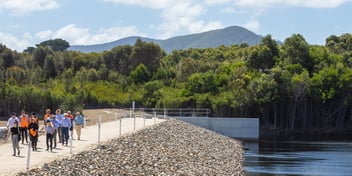Going digital: how one utility reinvented its virtual presence during a pandemic

When the COVID-19 pandemic began closing down workplaces across Australia in March 2020, organisations all over the country had to rapidly work out how they could conduct their activities virtually.
For water utility TasWater, however, the online transition was a journey on which they had already set out. When the pandemic hit Australia, TasWater had already begun shifting its intranet on to Microsoft’s SharePoint Online platform as part of the utility’s Virtual Workplace Program, which created an online virtual workplace for all its employees and trusted external parties.
Set to present at Ozwater’23 on going digital during a period of high turbulence, TasWater Corporate Communications Operations Manager Corey Speers said it made sense to use the start of the pandemic as a test case and to shift the utility’s information and documentation on to SharePoint.
“We'd already started the project – the investigation phase was underway – so it made perfect sense that we would start using it to complement our existing systems,” he said.
“It was a very timely rollout because the project had already kicked off and was firing in terms of what the structure was going to look like and how we were actually going to do this within the organisation.”
Speers said TasWater wanted the solution to be more than simply a source of information.
“From the outset, we had a pretty clear intention that it wasn't just a standalone intranet; it would also be about knowledge and collaboration in terms of document [and] records management, as well as team collaboration,” he said.
“As we were rolling it out following the peak of the pandemic, a lot of work went into building out the intranet based on what we've learned from our previous intranet, including what wasn't working and what needed to come over, and what else could be removed as we were making that transition.
“A lot of that work really started to happen in 2021, but we'd already laid the foundations. And that's how COVID helped; we’d already started putting a lot of this information out, and we knew what we were intending to build and how all this communication could complement that work.”
Centralised communications
Rolling out the Virtual Workplace Program presented some particular challenges – as well as opportunities – related to TasWater’s business as a utility.
Speers said the utility needed to ensure the system could be a central source of truth for TasWater’s water treatment plants and sewage treatment plants, as well as the many other services it operates.
The utility is, for instance, currently constructing individual pages for each of its plants across the state.
“For any site, you can go to all of the information related to that site … you can go to the one page and everything you need is there. In the past, the documents would have been stored in multiple places,” Speers said.
"So [the system] really brings all of that information into one central location. And this is all built in within the same infrastructure, so it's not like you have to go off somewhere else hunting that down.”
This also means many of the features can be accessed remotely from workers onsite at the plants.
“I wouldn't say we've got 100% available on the cloud, but I'd say a vast majority of the information that people need – or documents – would now be living on SharePoint,” Speers said.
“That's another benefit of SharePoint over our previous intranet: as long as you've got your credentials all set up, and you've got a device that can send you a text message … you can access it from anywhere.”
Global recognition
With implementation of the solution completed in July 2021, TasWater has had 18 months to gauge its effectiveness and, so far, the reviews have been positive.
And that isn’t just the internal response; this past August, the utility was recognised with a silver award at the global Step Two Intranet and Digital Workplace Awards.
“That was really good recognition of the project,” Speers said.
“It is multifaceted and is complementary; that's really something we wanted it to do. We didn't want it to be just another intranet that is old and covered in dust the minute you launch it.”
According to Speers, the program has allowed the utility to democratise across its teams the responsibility for ensuring information is accurate and up to date.
“Whereas in the past – like any intranet – it was largely the responsibility of one team and therefore, five minutes after something was published, it was out-of-date. Having everything in one central location, as opposed to in multiple places, that's definitely made it easier,” he said.
“Another thing SharePoint has been useful for is incident management. Whether it's a boil water alert, public health alert or during the recent floods late last year — all of that information now goes on a team collaboration site.
“Anyone who's involved in the incident is able to go into one location [with] all of the information about who's doing what – if there's communications, or if there's updates or anything like that, that all goes on the team site.”
“We used to do that all via email and shared network drives, and it could be very, very difficult to find information quickly, which is what you need to do in an incident; you need to have that information at your fingertips ready to go.”
Speers will discuss more about the details and accomplishments involved in the roll-out of TasWater’s Virtual Workplace Program during the COVID-19 pandemic in his presentation at OzWater’23 in Sydney this May: “The Perfect Storm: Building a virtual workplace in a pandemic”.

